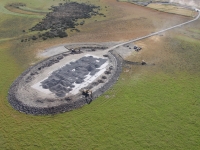The wetlands at Tule Lake NWR are mainly sumps maintained by return flows from adjacent irrigated agricultural fields. Tule Lake NWR is located east of the Lower Klamath NWR near the town of Tulelake, CA and is owned and managed by the U.S. Fish and Wildlife Service as part of the Klamath Basin NWR Complex. Large numbers of Caspian terns (ca. 500 adults) nested at Tule Lake in 1899; more recently, colony size estimates ranged from 4-80 breeding pairs during 1952-1962, when they nested on islands located in the Tule Lake sumps. These islands have been greatly reduced in size due to erosion and Caspian terns have not nested at Tule Lake NWR since the early 1960s. Tule Lake NWR is listed as one of five sites in interior Oregon and northeastern California where resource managers intend to create nesting habitat for Caspian terns in an effort to provide alternative habitat for the large tern colony on East Sand Island in the Columbia River estuary.
 The U.S. Army Corps of Engineers, in partnership with the U.S. Fish and Wildlife Service, constructed a 2-acre rock-core island in Tule Lake Sump 1B during late summer 2009. This new island was intended to provide nesting habitat for Caspian terns and other colonial waterbirds at the Tule Lake NWR. Because of severe drought in the Upper Klamath Basin, however, the island will become land-bridged early in the breeding season, and will not be suitable for tern nesting in 2010. Consequently, no effort will be made in 2010 to attract Caspian terns to nest at the Tule Lake tern island. Once the drought breaks, hopefully in 2011, Caspian tern decoys and audio systems that broadcast Caspian tern calls will be installed on the Tule Lake tern island in an effort to attract terns to nest at the site.
The U.S. Army Corps of Engineers, in partnership with the U.S. Fish and Wildlife Service, constructed a 2-acre rock-core island in Tule Lake Sump 1B during late summer 2009. This new island was intended to provide nesting habitat for Caspian terns and other colonial waterbirds at the Tule Lake NWR. Because of severe drought in the Upper Klamath Basin, however, the island will become land-bridged early in the breeding season, and will not be suitable for tern nesting in 2010. Consequently, no effort will be made in 2010 to attract Caspian terns to nest at the Tule Lake tern island. Once the drought breaks, hopefully in 2011, Caspian tern decoys and audio systems that broadcast Caspian tern calls will be installed on the Tule Lake tern island in an effort to attract terns to nest at the site.



